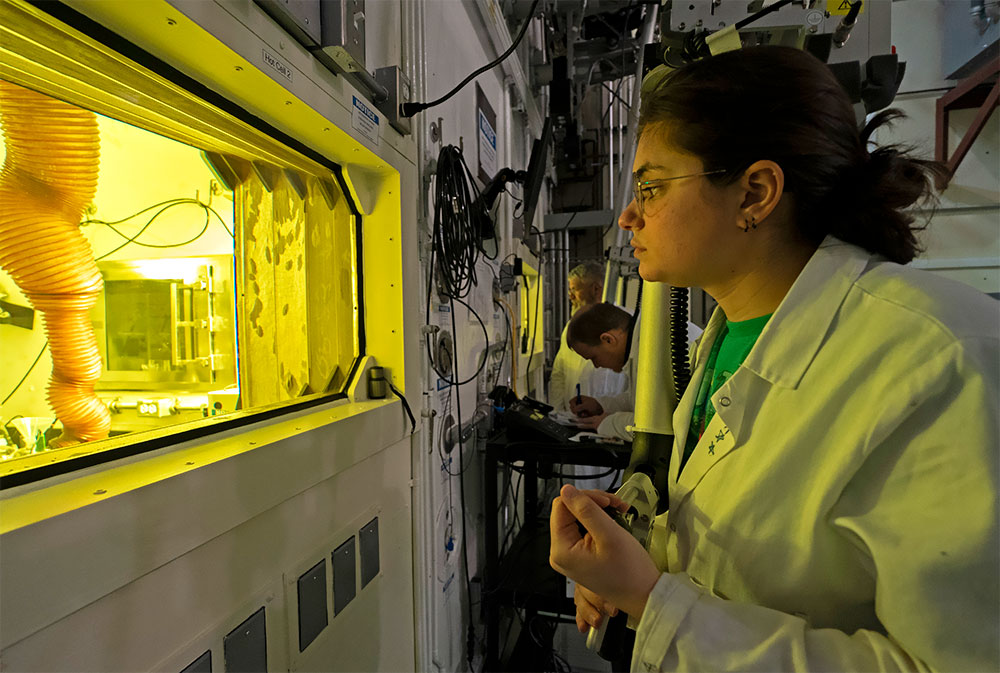 Following recent upgrades, the medical isotope facilities at the US Department of Energy’s (DOE’s) Brookhaven National Laboratory (BNL) is now producing actinium-225 (Ac-225) and shipping it directly to customers. Ac-225 is considered to have great potential in the treatment of cancer. It emits alpha particles, which can kill cancerous cells at short range is attach to molecules that target tumours. Ac-225 can also be used to generate bismuth-213, another alpha-emitter.
Following recent upgrades, the medical isotope facilities at the US Department of Energy’s (DOE’s) Brookhaven National Laboratory (BNL) is now producing actinium-225 (Ac-225) and shipping it directly to customers. Ac-225 is considered to have great potential in the treatment of cancer. It emits alpha particles, which can kill cancerous cells at short range is attach to molecules that target tumours. Ac-225 can also be used to generate bismuth-213, another alpha-emitter.
“This upgrade will streamline the overall production and distribution of Ac-225 to research centres by eliminating the need to ship material off site for final processing,” said Cathy Cutler, Director of Medical Isotope Research & Production (MIRP) at BNL. MIRP scientists have been part of the DOE Isotope Programme “Tri-Lab” effort to produce Ac-225 (and Ac-225/Bi-213 generators) since 2014.
Using powerful proton accelerators, scientists at Brookhaven and Los Alamos National Laboratory (LANL) irradiate targets made of thorium-232. transforming some of the thorium atoms into actinium-225. Both BNL and LANL have been shipping their irradiated targets to Oak Ridge National Laboratory (ORNL), which has the facilities to extract and purify the isotope.
The Tri-Lab programme established reliable, routine Ac-225 production, and demonstrated that the process is scalable. However, the limited “hot-cell” space limited the quantities of Ac-225 that could be produced.
In 2018, BNL and DOE team and DOE began refurbishing an old metallurgical laboratory that had been unused at Brookhaven since the 1990. An $8.5m investment from the DOE Science Laboratories Infrastructure programme made the renovation possible. The upgrade included retrofitting the obsolete hot cell facility and labs to create a new All-Purpose (AP) Hot Cell facility. “ORNL aided us in translating the process here. We also had to get special licensing and install new radiation-monitoring equipment,” Cutler said.
Brookhaven’s new AP hot cells were completed in March and have doubled the number of Ac-225 processing sites for DOE’s Isotope Programme. This expanded processing capacity provides redundancy so BNL and ORNL can act as back-ups for each other.
Scientists discovered actinium-225's in the 1960s when scientists at the DOE's Hanford Site were producing uranium-233 as a fuel for nuclear weapons and reactors. They shipped some of the uranium-233 production targets to ORNL for processing. The targets also contained thorium-229, which decays into actinium-225. In 1994, a team from ORNL began started extracting thorium-229 from the target material and eventually established a thorium "cow”, from which they could regularly "milk” actinium-225. In August 1997, the first delivery of actinium-225 was made to the National Cancer Institute.
Scientists at ORNL "milked” the thorium-229 cow six to eight times a year. They use a technique that separates out ions based on their charges. Unfortunately, the small amount of thorium-229 limits how much actinium-225 scientists can produce.
The Tri-Lab project team began to look for alternatives to ORNL’s “cow” and BNL's medical isotope research and production programme seemed to be the answer. Only a few US accelerators create high enough energy proton beams to generate actinium-225. BNL's Linear Accelerator and LANL's Neutron Science Centre are two of them. While both mainly focus on other nuclear research, they create plenty of excess protons for producing isotopes.
The actinium-225 production process starts with a target made of thorium that is bombarded with protons at about 40% the speed of light. As the protons hit thorium nuclei, they raise the energy of the protons and neutrons in the nuclei giving some enough kinetic energy escape the thorium atom. In addition, some of the excited nuclei split in half. The process of expelling protons and neutrons as well as splitting transforms the thorium atoms into hundreds of different isotopes including actinium-225.
After 10 days of proton bombardment, scientists removed the target and allowed short-lived radioisotopes can decay, reducing radioactivity. They then removed it from its initial packaging, analyse it, and repackaged it for shipping to ORNL for further processing. This last step is no longer needed with the BNL upgrade.
Image: A member of Brookhaven National Laboratory's MIRP team in the new hot-cell area used for processing targets to make medical isotopes such as actinium-225 (courtesy of BNL)



